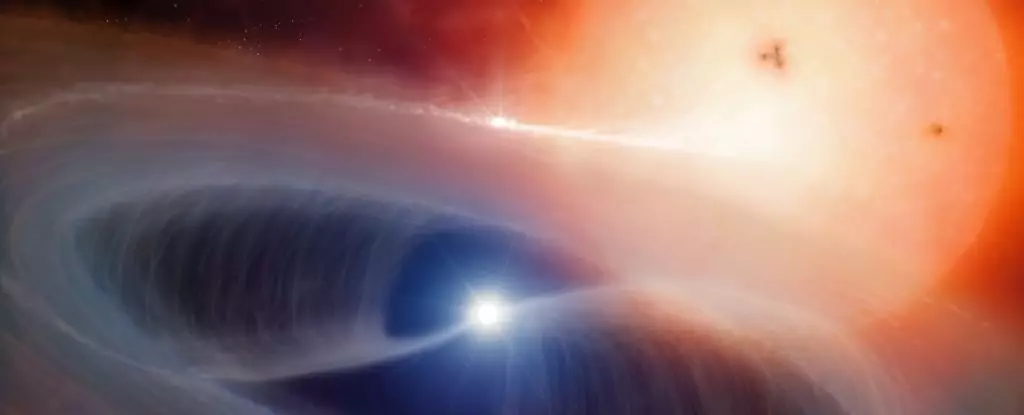The profound quest to comprehend the origins of metals in our universe continues to intrigue astronomers and astrophysicists alike. While the synthesis of elements through cosmic events is a well-acknowledged fact, discerning the distinct processes and sources behind these metallic creations remains challenging. Recent findings led by a team of researchers from Adam Mickiewicz University in Poland have provided critical insights into the less commonly targeted progenitors of Type Ic supernovae, identifying them as typically less massive stars with binary companions, rather than the traditionally considered massive singular stars.
Supernova explosions are monumental events in a star’s lifecycle, marking their transition from a source of light to a catalyst for metal formation. Type Ic supernovae, in particular, result from core collapses in massive stars that have exhausted their nuclear fuel. As heavier elements accumulate in the stellar cores, the energy required for fusion exceeds that which is released during the process, leading to a catastrophic inward gravitational collapse. This event generates either a neutron star or a black hole, while simultaneously ejecting enriched material into the surroundings, contributing to the cosmic abundances of elements such as carbon and oxygen.
However, Type Ic supernovae present a unique conundrum in their elemental composition. Unlike other types, they are characterized by a noticeable absence of hydrogen and helium within their observable ejecta. Contrasting theories have emerged, suggesting that either the progenitor stars are exceptionally massive—around 20 to 30 solar masses, surfacing strong stellar winds that blow away lighter elements—or that a binary companion siphons these elements away from a slightly less massive primary star (8 to 15 solar masses). The investigation into this phenomenon highlights a significant paradigm shift in our understanding of stellar lifecycles.
The recent scrutiny of Type Ic supernovae by Martín Solar and Michał Michałowski, alongside their colleagues, reveals that these cosmic events are often the results of interaction between massive stars and their binary partners. The findings suggest that many progenitors, rather than being isolated titans of the cosmos, are more frequently low-to-moderate mass stars that exist within binary systems. Through observations of molecular gas left in the aftermath of supernovae, the researchers discovered that the amount of hydrogen present correlates with the masses of the originating stars. Specifically, findings indicated that Type Ic progenitors were less formidable than previously thought.
The role of a binary companion varies significantly. In the face of a supernova explosion, the companion star typically remains intact and is often ejected at a high velocity, leading to altered trajectories as it continues to shine in the cosmos. This interaction not only resolves the mystery surrounding the lack of hydrogen and helium in Type Ic explosions but also sheds light on the ongoing contributions of various stellar processes to elemental abundance across the universe.
Understanding the progenitors of Type Ic supernovae and their binary companions carries compelling implications for the field of astrophysics. It allows scientists to recalibrate their models of nucleosynthesis and re-evaluate the contributions of these explosions to the cosmic inventory of elements. The research also enhances our understanding of carbon production—an element foundational to life itself—suggesting that Type Ic supernovae significantly augment the galactic carbon budget.
This line of investigation encourages more comprehensive astroforensics, where astronomers hope to analyze a larger sample of supernova remnants to reconstruct stellar histories. As Michałowski stated, the potential to compare individual supernovae based on newfound properties could yield unprecedented revelations about the evolving dynamics of stars, informing us about the broader mechanisms influencing stellar formation and death.
The importance of the findings cannot be overstated. As researchers continue to target the remnants of Type Ic supernovae, they strive for a more granular understanding of how these events shape their surrounding environments and influence future stellar generations. Questions remain about whether particular spectral characteristics, like broad emission lines, correlate with specific star types or how the properties of host galaxies affect supernova events.
The discovery of binary companions as critical players in the evolution of Type Ic supernovae presents a paradigm shift in our understanding of stellar evolution, metal creation, and cosmic history. As we continue to uncover the mysteries of the universe, the interplay between stellar systems remains a crucial focal point, guiding humanity toward a deeper cosmic understanding.


Leave a Reply